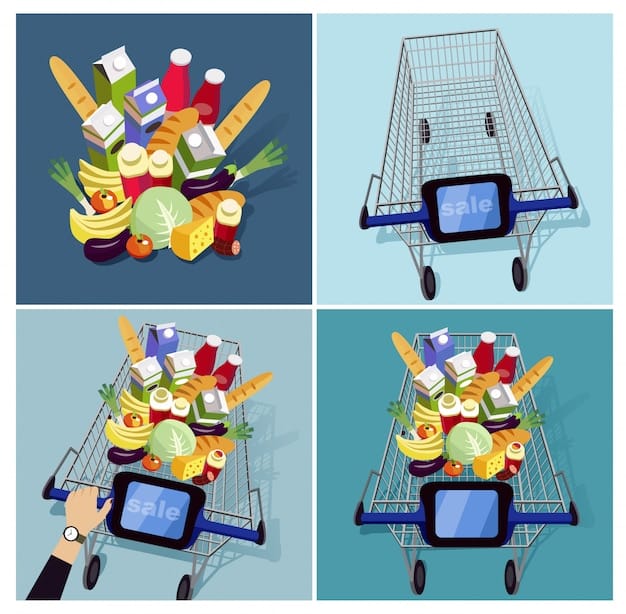Save Big: Your Guide to 25% Off Groceries at Discount Stores

Saving up to 25% on groceries is achievable by strategically shopping at discount grocery stores, focusing on store brands, planning meals, and utilizing available coupons and loyalty programs.
Want to cut your grocery bill without sacrificing quality? Learning how to save up to 25% on groceries by shopping at discount grocery stores can make a significant difference in your budget. This guide provides practical strategies to maximize your savings.
Discover the Power of Discount Grocery Stores
Discount grocery stores offer a fantastic opportunity to save money on essential food items. These stores often focus on providing value, offering lower prices compared to traditional supermarkets.
Understanding the landscape of discount grocery stores and the strategies for maximizing savings can transform your shopping habits.
What Makes a Grocery Store a “Discount” Store?
Discount grocery stores distinguish themselves through various operational and sourcing strategies that allow them to offer lower prices. Here’s what sets them apart:
- Reduced Overheads: They often operate in smaller and less lavish locations, cutting down on rental and operational costs.
- Focus on Store Brands: Discount stores heavily promote their own private label brands, which are typically cheaper than national brands.
- Efficient Supply Chains: They negotiate bulk purchasing deals and streamline their supply chain to minimize costs.
- Limited Services: Some might offer fewer services, like in-store bakeries or delis, which helps reduce labor costs.
Top Discount Grocery Store Chains in the US
Several major players dominate the US discount grocery market, each with its unique appeal. Some popular options include:
- Aldi: Known for its highly efficient operations and a wide range of store-brand products.
- Lidl: A European import that offers a mix of European and American products at competitive prices.
- Grocery Outlet: Sells deeply discounted, overstocked, or close-dated items from other retailers.
- Dollar General/Dollar Tree: While not strictly grocery stores, they offer many household staples and food items at very low prices.

By understanding the nature of discount grocery stores and familiarizing yourself with the top chains, you can begin to strategically plan your shopping trips to maximize savings.
Master the Art of Meal Planning and List Creation
Effective meal planning and detailed list creation are crucial for saving money at any grocery store, especially a discount one. These practices help you avoid impulse purchases and ensure you only buy what you need.
Taking the time to plan your meals for the week and create a corresponding shopping list will significantly impact your grocery bill.
How to Plan Your Meals Effectively
Meal planning doesn’t have to be complex. Here are some steps to make it a breeze:
- Take Inventory: Start by checking what you already have in your pantry, refrigerator, and freezer.
- Choose Recipes: Select recipes that utilize ingredients you already have or can easily find at discount prices.
- Consider Sales: Look at the weekly ads for your local discount grocery store to see what’s on sale. Incorporate those items into your meal plan.
- Plan for Leftovers: Intentionally plan for meals that can be repurposed into leftovers for lunch or another dinner.
Crafting a Detailed Shopping List
A well-organized shopping list keeps you focused and prevents unnecessary spending. Here’s how to create one:
- Categorize Items: Group items by store section (e.g., produce, dairy, frozen foods) to make your shopping trip more efficient.
- Be Specific: Note the exact quantity and type of each item needed.
- Stick to the List: Resist the urge to deviate from your list, even if something looks like a good deal.
With thoughtful meal planning and a detailed shopping list, you’re well-equipped to navigate discount grocery stores strategically and avoid overspending.
Embrace Store Brands and Generic Products
One of the biggest advantages of shopping at discount grocery stores is the availability of high-quality store brands and generic products at significantly lower prices than national brands.
Accepting and embracing these alternative products is a cornerstone of saving money on groceries.
The Quality of Store Brands vs. National Brands
Many consumers are hesitant to switch to store brands, but the truth is, the quality is often comparable to national brands. In many cases, store brands are produced in the same factories as their branded counterparts.
The key differences often lie in the packaging and marketing, which brand-name companies invest heavily in. Store brands cut these costs, passing the savings on to you.
Tips for Trying New Store Brands
If you’re new to store brands, here are some tips to make the transition easier:
- Start with Staples: Begin by replacing staples like milk, eggs, and bread with store brands.
- Read Reviews: Check online reviews or ask other shoppers for their opinions on specific store brands.
- Compare Ingredients: Read the ingredient lists to ensure the store brand offers similar nutritional value to the national brand.
- Try Small Sizes: Purchase smaller sizes of new store brands to test them before committing to larger quantities.

By overcoming the stigma associated with store brands and embracing generic products, you can unlock substantial savings without compromising on quality.
Maximize Savings with Coupons and Loyalty Programs
Even when shopping at discount grocery stores, coupons and loyalty programs can further enhance your savings. Many discount stores offer their own loyalty programs or accept manufacturer coupons.
Leveraging these resources can lead to even greater discounts, especially on frequently purchased items.
Exploring Available Coupons
Coupons come in various forms, each offering unique ways to save:
- Manufacturer Coupons: These are issued by the product manufacturer and can be found online, in newspapers, or through coupon apps.
- Store Coupons: Many discount grocery stores offer their own coupons, which can be found in weekly ads, in-store flyers, or on the store’s website.
- Digital Coupons: Some stores offer digital coupons that can be loaded onto your loyalty card or redeemed through a mobile app.
Leveraging Loyalty Programs for Additional Discounts
Loyalty programs reward repeat customers with exclusive discounts, personalized offers, and other perks. Check if your local discount grocery store offers a loyalty program.
Some programs may provide points for every dollar spent, which can be redeemed for discounts on future purchases. Others may offer exclusive deals on certain products or free items on your birthday.
By actively seeking out coupons and maximizing loyalty program benefits, you can unlock substantial savings on your grocery bill, even at discount stores.
Shop Seasonally and Buy in Bulk
Shopping seasonally and buying in bulk are time-tested strategies for saving money on groceries. These approaches allow you to take advantage of lower prices when produce is in abundance and stock up on essential items when they are on sale.
These strategies will optimize your budget and reduce the frequency of shopping trips.
The Benefits of Seasonal Shopping
Buying produce when it’s in season offers several advantages:
- Lower Prices: When fruits and vegetables are in season, they are more abundant, leading to lower prices.
- Better Quality: Seasonal produce is typically fresher and more flavorful, as it doesn’t have to travel long distances.
- Support Local Farmers: Shopping seasonally supports local farmers and reduces the environmental impact of transportation.
Smart Bulk Buying Practices
Buying in bulk can be a great way to save money, but it’s important to do it strategically:
- Consider Shelf Life: Only buy items in bulk that you know you will use before they expire.
- Compare Unit Prices: Calculate the unit price (price per ounce or pound) to ensure you’re actually getting a better deal.
- Storage Space: Make sure you have adequate storage space for bulk purchases.
By shopping seasonally and buying in bulk strategically, you can take advantage of lower prices and ensure you always have essential items on hand, all while saving money.
Reduce Food Waste and Extend Shelf Life
Minimizing food waste is not only environmentally responsible but also economically smart. Learning how to properly store food and repurpose leftovers can significantly reduce your grocery bill.
Implementing best practices for food storage and waste reduction will have a meaningful impact on your budget and the environment.
Effective Food Storage Techniques
Proper food storage is essential for extending the shelf life of your groceries:
- Proper Containers: Use airtight containers to store leftovers and prevent spoilage.
- Optimal Temperatures: Store food at the correct temperature in your refrigerator and freezer.
- First In, First Out (FIFO): Rotate your food items, placing older items in front and newer items in back.
Creative Ways to Use Leftovers
Leftovers don’t have to be boring. Get creative with repurposing them into new meals:
- Transform Ingredients: Roast chicken leftovers can be used in tacos, salads, or sandwiches.
- Soup It Up: Vegetable scraps can be turned into a nutritious soup.
- Freezing: Freeze leftover portions for quick and easy meals on busy days.
By adopting effective food storage techniques and creatively repurposing leftovers, you can minimize waste and maximize the value of your grocery purchases.
| Key Point | Brief Description |
|---|---|
| 💰 Discount Stores | Shop at stores like Aldi and Lidl for lower prices. |
| 🗓️ Meal Planning | Plan meals and create a detailed shopping list to avoid impulse buys. |
| 🏷️ Store Brands | Opt for store brands and generic products for significant savings. |
| ♻️ Reduce Waste | Use leftovers creatively and store food properly to minimize waste. |
Frequently Asked Questions
▼
In many cases, yes. Store brands often come from the same manufacturers as name brands but are sold at a lower price due to reduced marketing costs.
▼
Check the store’s website, weekly ads, and in-store flyers. Also, use coupon apps and websites to find manufacturer coupons that can be used.
▼
Start by checking what you already have, plan meals around sale items, and incorporate leftovers into future meals to reduce waste.
▼
Yes, but only if you’ll use the items before they expire. Always compare unit prices to ensure you’re getting a better deal than buying smaller quantities.
▼
Store food properly in airtight containers, use leftovers creatively, and freeze excess portions for future meals to minimize waste and save money.
Conclusion
By embracing these strategies, you can significantly reduce your grocery bill, potentially saving up to 25% by shopping at discount grocery stores. Embrace store brands, plan your meals intelligently, and reduce waste to see the savings add up.





